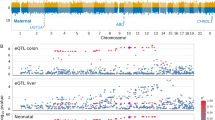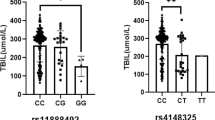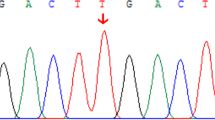Abstract
The uridine diphosphoglucuronate-glucuronosyltransferase 1A1 (UGT1A1) gene encodes the enzyme responsible for bilirubin glucuronidation. To evaluate the contribution of UGT1A1 promoter mutations to neonatal jaundice, we determined the genotypes of c.-3279T>G, c.-3156G>A, and A(TA)7TAA in Malay infants with neonatal jaundice (patients) and in infants without neonatal jaundice (controls). In our population study, only c.-3279T>G was associated with neonatal jaundice. The genotype distributions between both groups were significantly different (p = 0.003): the frequency of homozygosity for c.-3279G was much higher in patients than those in controls. Allele frequency of c.-3279G was significantly higher in patients than those in controls (p = 0.006). We then investigated changes in transcriptional activity because of c.-3279T>G. Luciferase reporter assay in HepG2 cells demonstrated that transcriptional activity of the c.-3279G allele was significantly lower than that of the c.-3279T allele in both the absence and presence of bilirubin. Luciferase reporter assay in COS-7 cells elucidated that c.-3279T>G modified the synergistic effects of the nuclear factors associated with transcriptional machinery. In conclusion, the c.-3279T>G mutation in the UGT1A1 promoter is a genetic risk factor for neonatal jaundice.
Similar content being viewed by others
Log in or create a free account to read this content
Gain free access to this article, as well as selected content from this journal and more on nature.com
or
Abbreviations
- AhR:
-
human aryl hydrocarbon receptor
- Arnt:
-
human aryl hydrocarbon receptor nuclear translocator
- CAR:
-
human constitutive androstane receptor
- GS:
-
Gilbert's syndrome
- gtPBREM:
-
Phenobarbital responsive enhancer module in UGT1A1
- RXR:
-
human retinoid X receptor α
- UGT1A1:
-
uridine diphosphoglucuronate-glucuronosyltransferase 1A1
References
Seppen J, Bosma PJ, Goldhoorn BG, Bakker CT, Chowdhury JR, Chowdhury NR, Jansen PL, Oude Elferink RP 1994 Discrimination between Crigler-Najjar type I and II by expression of mutant bilirubin uridine diphosphate-glucuronosyltransferase. J Clin Invest 94: 2385–2391
Kadakol A, Ghosh SS, Sappal BS, Sharma G, Chowdhury JR, Chowdhury NR 2000 Genetic lesions of bilirubin uridine-diphosphoglucuronate glucuronosyltransferase (UGT1A1) causing Crigler-Najjar and Gilbert syndromes: correlation of genotype to phenotype. Hum Mutat 16: 297–306
Bosma PJ, Chowdhury JR, Bakker C, Gantla S, de Boer A, Oostra BA, Lindhout D, Tytgat GN, Jansen PL, Oude Elferink RP, Chowdhury NR 1995 The genetic basis of the reduced expression of bilirubin UDP-glucuronosyltransferase 1 in Gilbert's syndrome. N Engl J Med 333: 1171–1175
Monaghan G, Ryan M, Seddon R, Hume R, Burchell B 1996 Genetic variation in bilirubin UPD-glucuronosyltransferase gene promoter and Gilbert's syndrome. Lancet 347: 578–581
Ciotti M, Chen F, Rubaltelli FF, Owens IS 1998 Coding defect and a TATA box mutation at the bilirubin UDP-glucuronosyltransferase gene cause Crigler-Najjar type I disease. Biochim Biophys Acta 1407: 40–50
Bancroft JD, Kreamer B, Gourley GR 1998 Gilbert syndrome accelerates development of neonatal jaundice. J Pediatr 132: 656–660
Beutler E, Gelbart T, Demina A 1998 Racial variability in the UDP-glucuronosyltransferase 1 (UGT1A1) promoter: a balanced polymorphism for regulation of bilirubin metabolism?. Proc Natl Acad Sci USA 95: 8170–8174
Akaba K, Kimura T, Sasaki A, Tanabe S, Ikegami T, Hashimoto M, Umeda H, Yoshida H, Umetsu K, Chiba H, Yuasa I, Hayasaka K 1998 Neonatal hyperbilirubinemia and mutation of the bilirubin uridine diphosphate-glucuronosyltransferase gene: a common missense mutation among Japanese, Koreans and Chinese. Biochem Mol Biol Int 46: 21–26
Sugatani J, Yamakawa K, Yoshinari K, Machida T, Takagi H, Mori M, Kakizaki S, Sueyoshi T, Negishi M, Miwa M 2002 Identification of a defect in the UGT1A1 gene promoter and its association with hyperbilirubinemia. Biochem Biophys Res Commun 292: 492–497
Innocenti F, Liu W, Chen P, Desai AA, Das S, Ratain MJ 2005 Haplotypes of variants in the UDP-glucuronosyltransferase1A9 and 1A1 genes. Pharmacogenet Genomics 15: 295–301
Sugatani J, Kojima H, Ueda A, Kakizaki S, Yoshinari K, Gong QH, Owens IS, Negishi M, Sueyoshi T 2001 The phenobarbital response enhancer module in the human bilirubin UDP-glucuronosyltransferase UGT1A1 gene and regulation by the nuclear receptor CAR. Hepatology 33: 1232–1238
Sai K, Saeki M, Saito Y, Ozawa S, Katori N, Jinno H, Hasegawa R, Kaniwa N, Sawada J, Komamura K, Ueno K, Kamakura S, Kitakaze M, Kitamura Y, Kamatani N, Minami H, Ohtsu A, Shirao K, Yoshida T, Saijo N 2004 UGT1A1 haplotypes associated with reduced glucuronidation and increased serum bilirubin in irinotecan-administered Japanese patients with cancer. Clin Pharmacol Ther 75: 501–515
Yusoff S, Van Rostenberghe H, Yusoff NM, Talib NA, Ramli N, Ismail NZ, Ismail WP, Matsuo M, Nishio H 2006 Frequencies of A(TA)7TAA, G71R, and G493R mutations of the UGT1A1 gene in the Malaysian population. Biol Neonate 89: 171–176
Sutomo R, Talib NA, Yusoff NM, Van Rostenberghe H, Sadewa AH, Sunarti Sofro AS, Yokoyama N, Lee MJ, Matsuo M, Nishio H 2004 Screening for G71R mutation of the UGT1A1 gene in the Javanese-Indonesian and Malay-Malaysian populations. Pediatr Int 46: 565–569
Gibbs RA, Nguyen PN, Caskey CT 1989 Detection of single DNA base differences by competitive oligonucleotide priming. Nucleic Acids Res 17: 2437–2448
Stephens M, Smith NJ, Donnelly P 2001 A new statistical method for haplotype reconstruction from population data. Am J Hum Genet 68: 978–989
Niu T 2004 Algorithms for inferring haplotypes. Genet Epidemiol 27: 334–347
Sugatani J, Mizushima K, Osabe M, Yamakawa K, Kakizaki S, Takagi H, Mori M, Ikari A, Miwa M 2008 Transcriptional regulation of human UGT1A1 gene expression through distal and proximal promoter motifs: implication of defects in the UGT1A1 gene promoter. Naunyn Schmiedebergs Arch Pharmacol 377: 597–605
Yueh MF, Huang YH, Hiller A, Chen S, Nguyen N, Tukey RH 2003 Involvement of the xenobiotic response element (XRE) in Ah receptor-mediated induction of human UDP-glucuronosyltransferase 1A1. J Biol Chem 278: 15001–15006
Kanai M, Kijima K, Shirahata E, Sasaki A, Akaba K, Umetsu K, Tezuka N, Kurachi H, Aikawa S, Hayasaka K 2005 Neonatal hyperbilirubinemia and the bilirubin uridine diphosphate-glucuronosyltransferase gene: the common-3263T > G mutation of phenobarbital response enhancer module is not associated with the neonatal hyperbilirubinemia in Japanese. Pediatr Int 47: 137–141
Huang W, Zhang J, Chua SS, Qatanani M, Han Y, Granata R, Moore DD 2003 Induction of bilirubin clearance by the constitutive androstane receptor (CAR). Proc Natl Acad Sci USA 100: 4156–4161
Togawa H, Shinkai S, Mizutani T 2008 Induction of human UGT1A1 by bilirubin through AhR dependent pathway. Drug Metab Lett 2: 231–237
Maruo Y, D'Addario C, Mori A, Iwai M, Takahashi H, Sato H, Takeuchi Y 2004 Two linked polymorphic mutations (A(TA)7TAA and T-3279G) of UGT1A1 as the principal cause of Gilbert syndrome. Hum Genet 115: 525–526
Costa E, Vieira E, Dos Santos R 2005 The polymorphism c.-3279T>G in the phenobarbital-responsive enhancer module of the bilirubin UDP-glucuronosyltransferase gene is associated with Gilbert syndrome. Clin Chem 51: 2204–2206
Ferraris A, D'Amato G, Nobili V, Torres B, Marcellini M, Dallapiccola B 2006 Combined test for UGT1A1-3279T–>G and A(TA)nTAA polymorphisms best predicts Gilbert's syndrome in Italian pediatric patients. Genet Test 10: 121–125
Boo NY, Wong FL, Wang MK, Othman A 2009 Homozygous variant of UGT1A1 gene mutation and severe neonatal hyperbilirubinemia. Pediatr Int 51: 488–493
Wong FL, Wang MK, Boo NY, Hamidah NH, Ainoon BO 2007 Rapid detection of the UGT1A1 single nucleotide polymorphism G211A using real-time PCR with Taqman minor groove binder probes. J Clin Lab Anal 21: 167–172
Zhou YY, Lee LY, Ng SY, Hia CP, Low KT, Chong YS, Goh DL 2009 UGT1A1 haplotype mutation among Asians in Singapore. Neonatology 96: 150–155
Kaplan M, Renbaum P, Vreman HJ, Wong RJ, Levy-Lahad E, Hammerman C, Stevenson DK 2007 (TA)n UGT 1A1 promoter polymorphism: a crucial factor in the pathophysiology of jaundice in G-6-PD deficient neonates. Pediatr Res 61: 727–731
Huang CS, Chang PF, Huang MJ, Chen ES, Chen WC 2002 Glucose-6-phosphate dehydrogenase deficiency, the UDP-glucuronosyl transferase 1A1 gene, and neonatal hyperbilirubinemia. Gastroenterology 123: 127–133
Cui Y, Konig J, Leier I, Buchholz U, Keppler D 2001 Hepatic uptake of bilirubin and its conjugates by the human organic anion transporter SLC21A6. J Biol Chem 276: 9626–9630
Huang MJ, Kua KE, Teng HC, Tang KS, Weng HW, Huang CS 2004 Risk factors for severe hyperbilirubinemia in neonates. Pediatr Res 56: 682–689
Zucker SD, Goessling W, Ransil BJ, Gollan JL 1995 Influence of glutathione S-transferase B (ligandin) on the intermembrane transfer of bilirubin. Implications for the intracellular transport of nonsubstrate ligands in hepatocytes. J Clin Invest 96: 1927–1935
Akizawa E, Koiwai K, Hayano T, Maezawa S, Matsushita T, Koiwai O 2008 Direct binding of ligandin to uridine 5′-diphosphate glucuronosyltransferase 1A1. Hepatol Res 38: 402–409
Gourley GR, Arend RA 1986 β-Glucuronidase and hyperbilirubinaemia in breast-fed and formula-fed babies. Lancet 1: 644–646
Maruo Y, Nishizawa K, Sato H, Sawa H, Shimada M 2000 Prolonged unconjugated hyperbilirubinemia associated with breast milk and mutations of the bilirubin uridine diphosphate-glucuronosyltransferase gene. Pediatrics 106: E59
Kawade N, Onishi S 1981 The prenatal and postnatal development of UDP-glucuronyltransferase activity towards bilirubin and the effect of premature birth on this activity in the human liver. Biochem J 196: 257–260
Acknowledgements
We thank the neonatal ward staffs in the Hospital of University Sains Malaysia, and infants and their parents for their willing participation in our study.
Author information
Authors and Affiliations
Consortia
Additional information
Supported by grants from the Ministry of Science, Culture, and Sports of Japan (Research Project Number: 15406036) and from the Ministry of Science, Technology and Innovation (MOSTI) eScience Fund of Malaysia (Research Project Number: 06-01-05-SF0166).
Rights and permissions
About this article
Cite this article
Yusoff, S., Takeuchi, A., Ashi, C. et al. A Polymorphic Mutation, c.-3279T>G, in the UGT1A1 Promoter Is a Risk Factor for Neonatal Jaundice in the Malay Population. Pediatr Res 67, 401–406 (2010). https://doi.org/10.1203/PDR.0b013e3181d22f78
Received:
Accepted:
Issue date:
DOI: https://doi.org/10.1203/PDR.0b013e3181d22f78
This article is cited by
-
The role of UGT1A1 (c.-3279 T > G) gene polymorphisms in neonatal hyperbilirubinemia susceptibility
BMC Medical Genetics (2020)
-
UGT1A1 gene and neonatal hyperbilirubinemia: a preliminary study from Bengkulu, Indonesia
BMC Research Notes (2018)
-
Clinical UGT1A1 Genetic Analysis in Pediatric Patients: Experience of a Reference Laboratory
Molecular Diagnosis & Therapy (2017)
-
UGT1A1 gene variants and clinical risk factors modulate hyperbilirubinemia risk in newborns
Journal of Perinatology (2014)



